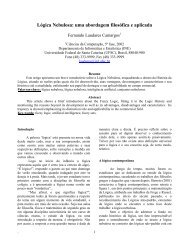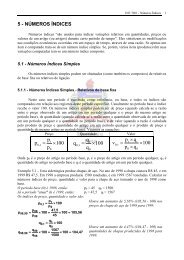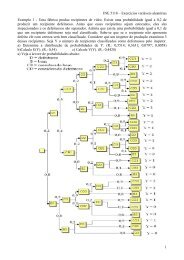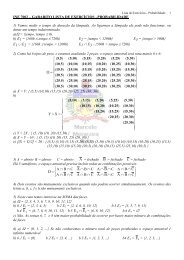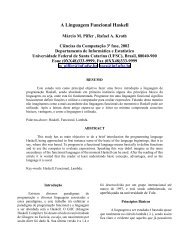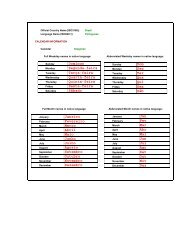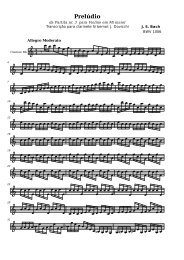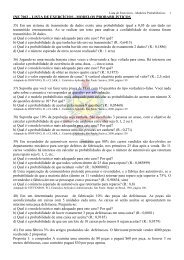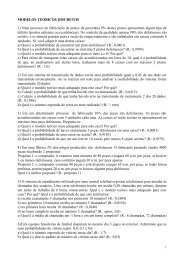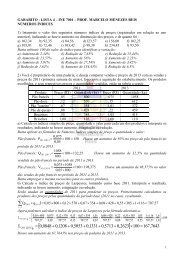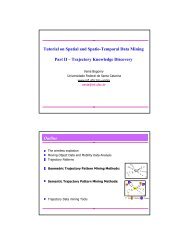Anais do IHC'2001 - Departamento de Informática e Estatística - UFSC
Anais do IHC'2001 - Departamento de Informática e Estatística - UFSC
Anais do IHC'2001 - Departamento de Informática e Estatística - UFSC
You also want an ePaper? Increase the reach of your titles
YUMPU automatically turns print PDFs into web optimized ePapers that Google loves.
238<br />
<strong>Anais</strong> <strong>do</strong> IHC’2001 - IV Workshop sobre Fatores Humanos em Sistemas Computacionais<br />
The interesting fact about Punnet Squares, from Stenning and In<strong>de</strong>r’s perspective, is the<br />
emerging meaning in the representation, that no genetic traits can be in<strong>de</strong>terminate.<br />
Therefore, the Punnet Square <strong>do</strong>es not easily yield itself to a continuous constructive<br />
progression of the concept. The table can only be filled out when and if the principle is<br />
fully known. It cannot be used in the process of learning the principle (where knowledge<br />
goes through successive stages of <strong>de</strong>creasing in<strong>de</strong>terminacy).<br />
These two brief examples from different <strong>do</strong>mains provi<strong>de</strong> us with some interesting insights<br />
regarding DCM and RDCM for interacting with learnware. They draw attention to the fact<br />
that the visual representation of in<strong>de</strong>terminacy requires diagrams or images that can<br />
represent types [Stenning & In<strong>de</strong>r, 1995; Stenning & Oberlan<strong>de</strong>r, 1995]. In<strong>de</strong>terminacy<br />
may be important for different reasons. First, it may be the case that there are cases of<br />
in<strong>de</strong>terminacy in the <strong>do</strong>main of knowledge being learned (see the Euler Circles example).<br />
Second, it may alternatively happen that, although there are no cases of in<strong>de</strong>terminacy in<br />
the <strong>do</strong>main, the gradual construction of knowledge structures may require the<br />
representation of in<strong>de</strong>terminate states in the learners’ conceptualizations (see the Punnet<br />
Square example).<br />
Viewed from this perspective, the evolution from DCM to RDCM interaction with Super<br />
Tangrams © corresponds to a gradual <strong>de</strong>crease of the referential <strong>de</strong>terminacy of visual<br />
representations until a minimal threshold is reached. Visual cases of in<strong>de</strong>terminacy, in ST,<br />
are compensated with internalized concepts that are arguably available in symbolic form<br />
(the pre-linguistic mental formulation of general principles that have been learned from<br />
previous more <strong>de</strong>terminate stages of representation). We can then anticipate that the style<br />
of learning a<strong>do</strong>pted in ST would not be easily reproducible for teaching Logic with Euler<br />
Circles or Genetics with Punnet Squares.<br />
Conclusion<br />
The previous sections give us some interesting elements to respond to the issues posed so<br />
far about the value of DCM and RDCM as distinct interface styles in learnware. Firstly, in<br />
semiotic terms DCM and RDCM can be argued to be more closely related than has been<br />
originally suggested. In fact, the phenomenological categories of secondness (that refers to<br />
establishing relations between two entities) and thirdness (that refers to establishing<br />
relations between at least three entities) can suitably characterize the interface signs used in<br />
Super Tangrams © . The relevance of this argument is that the availability of a theoretical<br />
framework that can a<strong>de</strong>quately account for <strong>de</strong>sign choices based on heuristic gui<strong>de</strong>lines<br />
and experimental observations allows us to explore a number of predictions and<br />
explanations of HCI phenomena in the <strong>do</strong>main of learnware. These predictions are backed<br />
by semiotic theory, and can help us not only probe the spectrum of possible answers to<br />
known questions, but perhaps more importantly to formulate new questions and advance<br />
our knowledge in the field.<br />
To illustrate this point, we can already conjecture about the issues raised in previous<br />
studies with the system.<br />
1. What visual representations [should we] use to facilitate [the] <strong>de</strong>velopment of proper<br />
conceptual mo<strong>de</strong>ls?<br />
Our analysis seems to support the conjecture that we should use those representations (a)<br />
that can be related to the secondness as well as thirdness of their objects, and (b) that can



